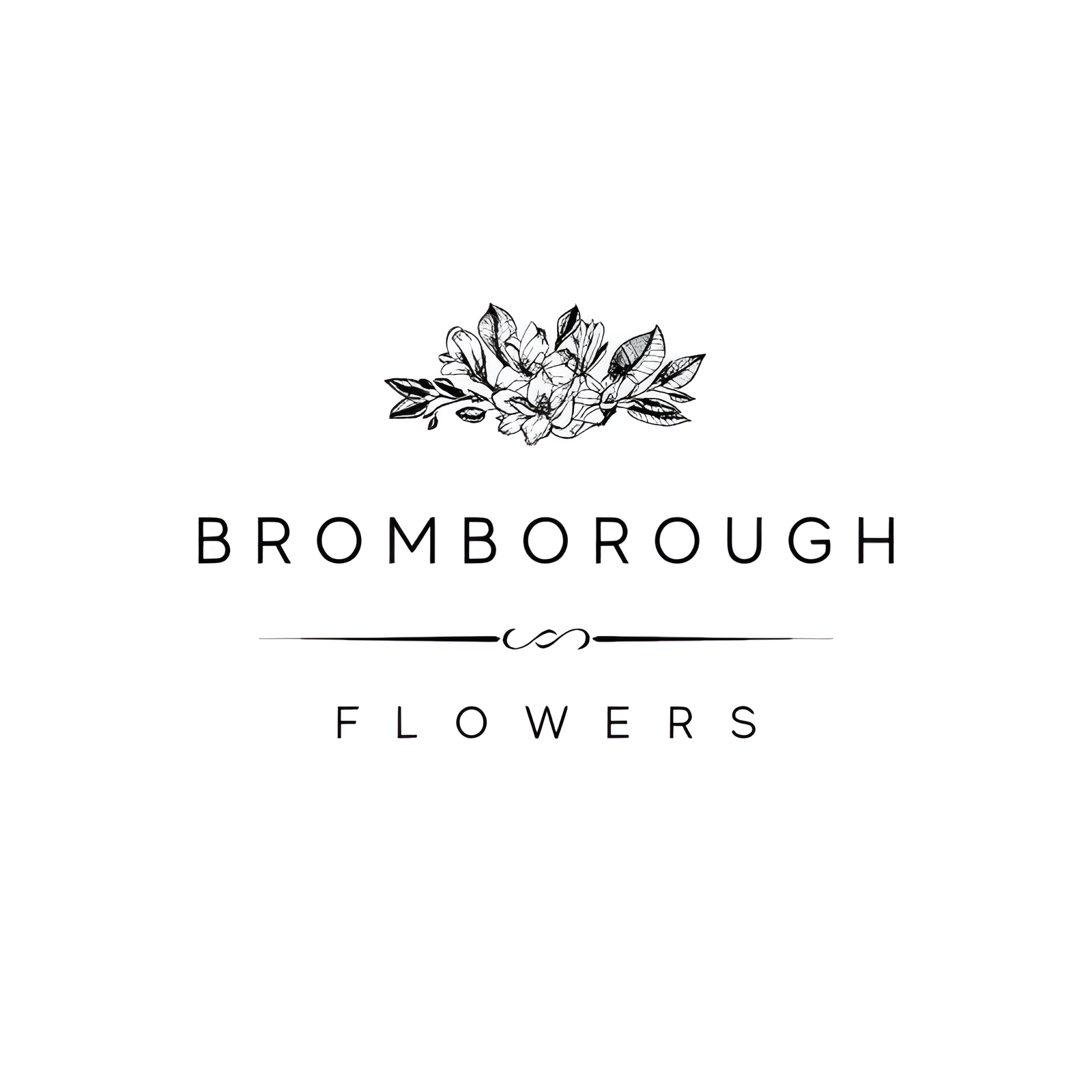The Primrose, with its delicate five-petaled blooms and charming rosettes of leaves, stands out as an exquisite choice for early spring weddings. Available in a spectrum of colors such as pink, purple, yellow, and white, these flowers bring a subtle yet profound elegance to bridal arrangements. Symbolizing young love and new beginnings, Primroses are perfect for couples wishing to incorporate a sense of natural beauty into their wedding. As we explore the various aspects of this enchanting flower, from its physical description to its cultural significance, discover how Primroses can elevate your wedding day with their timeless appeal.
Flower Overview
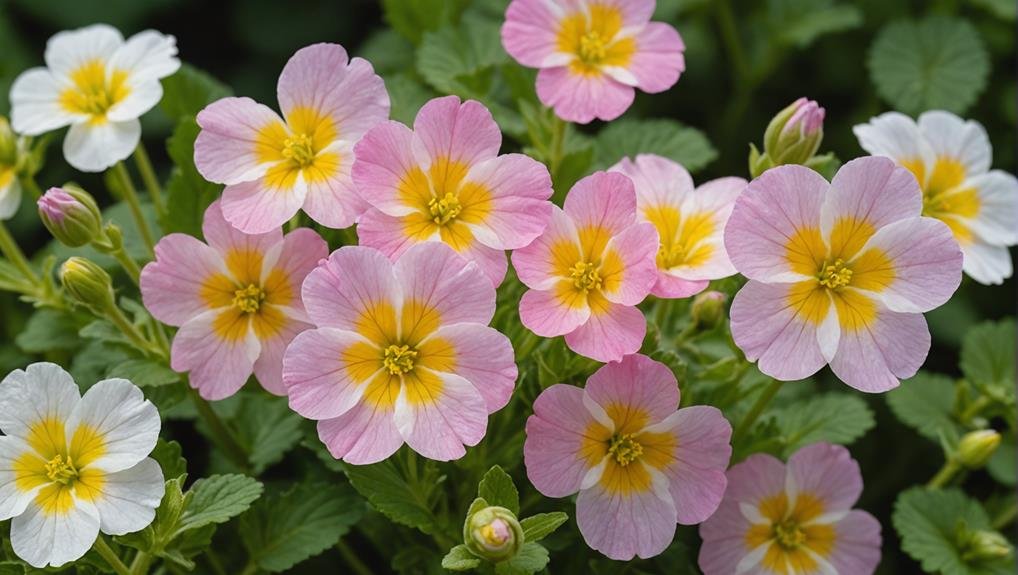
Primroses, with their delicate blooms and vibrant colors, are a quintessential choice for early spring weddings. These fresh flowers add an enchanting touch to bridal arrangements, enhancing the overall aesthetic of the event.
Available in an array of shades such as pink, purple, yellow, and white, primroses offer versatile options to complement various wedding color schemes. Their mild, sweet fragrance subtly infuses the air, contributing to a mesmerizing atmosphere without overwhelming the senses.
The unique five-petaled structure, often featuring a contrasting yellow center, makes primroses particularly appealing for wedding bouquets and floral decorations. These flowers not only serve as a visual delight but also carry symbolic significance, representing young love and new beginnings—an ideal sentiment for couples setting out on a lifelong journey together.
Integrating fresh flowers like primroses into wedding arrangements can elevate the ceremony's elegance and charm. Whether used in bouquets, centerpieces, or decorative accents, their presence underscores the vibrancy and beauty of spring, making them a fitting choice for any wedding celebration.
Their combination of aesthetic appeal and symbolic meaning underscores why they are favored by many brides and event planners.
Physical Description
Characterized by their rosettes of leaves and clusters of small, delicate, five-petaled flowers, these low-growing perennial plants belong to the Primulaceae family. Primroses display a distinct morphology that makes them a popular choice for bridal bouquets. The rosettes of leaves form a lush, green base from which slender stems emerge, each culminating in a cluster of charming blooms. These flowers typically measure about one inch in diameter, featuring a symmetrical arrangement that enhances their visual appeal.
In the context of a bridal bouquet, the primrose's compact size and delicate structure lend a touch of elegance and sophistication. The foliage, though understated, adds texture and depth, complementing the vibrant blooms. Additionally, the primrose's preference for cool, moist, and shady conditions makes it an ideal choice for spring weddings and early summer events. This ensures that the flowers remain fresh and vibrant throughout the ceremony and reception.
Primroses are often integrated into floral arrangements and ornamental displays due to their versatile and enduring beauty. Their subtle yet enchanting presence can elevate the aesthetic of any wedding, making them a cherished component of many bridal bouquets.
Available Colour Varieties
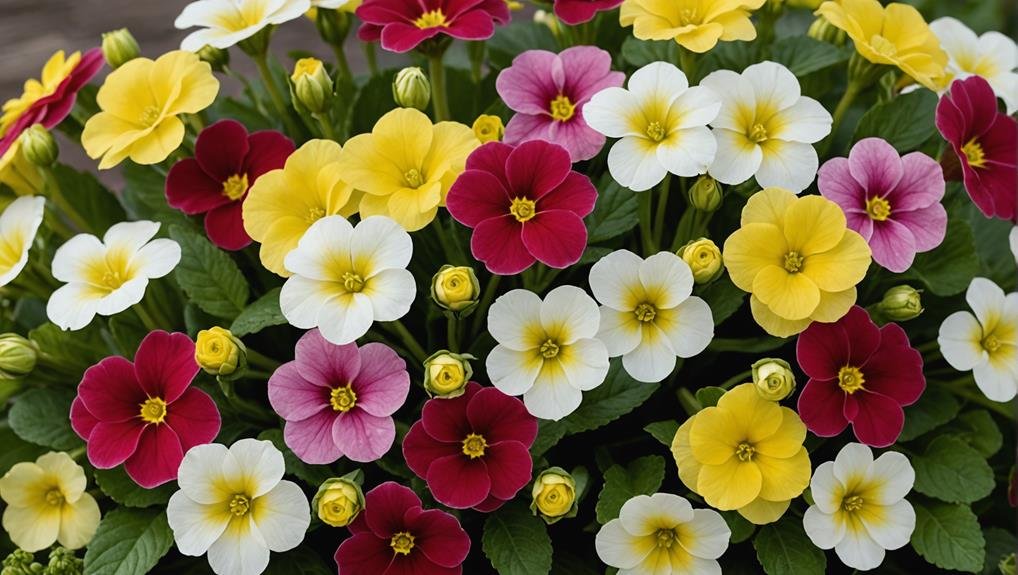
The diverse color palette of primroses greatly enhances their appeal for wedding floral arrangements. These charming flowers are available in a wide array of color varieties, including shades of pink, purple, yellow, white, and red. Such a vibrant spectrum allows for extensive creativity in designing bouquets and centerpieces that align with various wedding themes and color schemes.
Among the popular color varieties, lavender, magenta, peach, and pastel shades stand out, each bringing a unique touch to floral compositions. The versatility of primroses is further amplified by the availability of bicolored varieties. These bicolored primroses often feature contrasting or complementary hues, adding an extra layer of visual interest and sophistication to the arrangements.
The color of primroses can vary significantly based on the species and hybrid cultivars available. This variability ensures that there is a primrose to match almost any desired aesthetic, from bold and vibrant to soft and subtle.
Known for their eye-catching hues, primroses are a favored choice among florists and brides alike for adding a pop of color to wedding floral designs, ensuring that each arrangement is both striking and memorable.
Latin Name and Taxonomy
Known scientifically as Primula, the primrose belongs to the diverse and extensive Primulaceae family. This family comprises over 400 species, showcasing a remarkable variety of forms and colors. Primula vulgaris, often referred to as the common primrose, is one of the most recognized species within this vast family. These herbaceous flowering plants are characterized by their rosettes of leaves and vibrant, fragrant flowers, which add a delicate charm to any floral arrangement.
The Latin name, Primula, aptly reflects the plant's status as one of the first flowers to bloom in the spring, derived from the Latin word 'primus,' meaning first. The taxonomy of primroses is extensive, with species exhibiting a wide range of adaptability to different environments, from alpine regions to woodlands and meadows. This adaptability, coupled with their aesthetic appeal, makes primroses a popular choice for wedding bouquets and arrangements.
Primroses are available in a spectrum of colors, including pink, purple, yellow, white, and red, adding a touch of elegance and variety to floral designs. Their diverse color palette and fragrant blooms make them a versatile and favored option for wedding florists and brides alike.
Geographical Origins

Primroses, with their extensive adaptability and aesthetic appeal, have a rich geographical origin spanning Europe, Asia, and North America. These charming wedding flowers are native to cool, moist climates and can be found thriving in a variety of natural habitats, including woodlands, meadows, and riverbanks. The rich diversity of over 400 different species showcases their ability to adapt to various environmental conditions, making them a versatile choice for diverse garden settings and wedding arrangements.
Primroses have been cherished for centuries, and their early spring bloom is a reflection of their enduring popularity. The name 'primrose' is derived from the Latin term 'prima rosa,' which translates to 'first rose,' aptly reflecting their timely appearance as one of the first flowers to bloom in spring. This early blooming feature makes them a favorite for wedding flowers, as they can add a vibrant touch to spring ceremonies.
Key points about the geographical origins of primroses include:
- Native to Europe, Asia, and North America.
- Thrive in cool, moist climates.
- Commonly found in woodlands, meadows, and along riverbanks.
- Over 400 species adapting to various regions.
- Cultivated for centuries and popular in garden settings.
Primroses continue to enchant with their beauty and historical significance, making them a timeless choice for wedding flowers.
Season Availability
Seasonal availability plays an important role in the selection of primroses for wedding arrangements, mainly favoring spring and early summer months. These delicate flowers thrive in cooler temperatures, making them an ideal choice for spring weddings. Their vibrant colors and soft, velvety petals offer a charming and romantic aesthetic that enhances any bridal bouquet.
Primroses are renowned for their diverse color palette, featuring shades of pink, purple, yellow, and white. This versatility makes them a popular option not only for bridal bouquets but also for centerpieces and boutonnieres. Their dainty appearance adds a touch of elegance and whimsy, perfect for creating memorable wedding floral arrangements.
However, it is essential to note that the availability of primroses can vary depending on the region and local climate. Florists may need to be consulted to confirm specific availability in your area.
While their seasonal nature primarily restricts them to spring and early summer, this timeframe coincides with a popular wedding season, allowing many couples to incorporate these delightful flowers into their special day. To guarantee the freshest blooms, it's advisable to plan wedding floral arrangements accordingly, taking into account the seasonal availability of primroses.
Growing Conditions
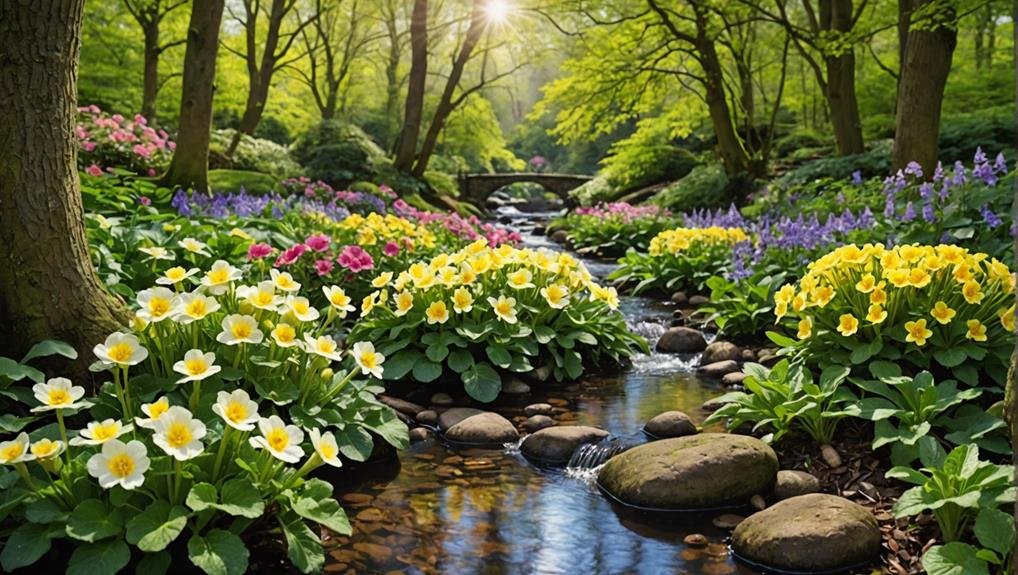
Optimal growing conditions for primroses involve maintaining a cool, moist environment with well-draining soil and partial shade. These conditions are essential for guaranteeing healthy plants and vibrant blooms, including the sought-after white blooms often highlighted in wedding arrangements. Primroses thrive best in temperatures ranging between 50-65°F (10-18°C) and can withstand light frosts, making them versatile for various climates.
To achieve best results, consistent watering is crucial to keep the soil evenly moist but not waterlogged, which can lead to root rot. Regular fertilization with a balanced, water-soluble fertilizer during the growing season will support robust growth and prolific flowering. Additionally, primroses can be cultivated in both containers and flower beds, offering flexibility in garden design and placement.
Key growing considerations include:
- Cool Environment: Maintain temperatures between 50-65°F (10-18°C).
- Consistent Moisture: Guarantee the soil is evenly moist without becoming waterlogged.
- Partial Shade: Provide protection from direct midday sun to prevent scorching.
- Well-Draining Soil: Prevent root rot by using soil that drains efficiently.
- Regular Fertilization: Use a balanced, water-soluble fertilizer during the growing season.
Cultural Significance
The cultural significance of primroses spans various traditions and histories, symbolizing young love, affection, and new beginnings. These delicate flowers have long been revered for their symbolic meanings, making them a popular choice in various cultural contexts.
In Celtic folklore, primroses were believed to possess magical powers, often used in love potions and charms to invoke affection and romantic feelings.
Primroses have also been utilized in traditional medicine, where they symbolize hope, new beginnings, and protection. Their healing properties have been well documented, further solidifying their role as symbols of rejuvenation and fresh starts.
The broad spectrum of colors in which primroses bloom adds layers to their symbolism, with each hue representing different facets of emotion and virtue. For instance, white primroses are often linked to innocence and youth, while darker shades like red may signify passion and deep devotion.
Throughout literature and art, primroses are frequently depicted as emblems of beauty and purity. Their presence in these cultural mediums underscores their enduring appeal and the rich tapestry of meanings they evoke.
Therefore, primroses hold a special place in the cultural and symbolic landscape, celebrated for their multifaceted significance.
Typical Use in Weddings
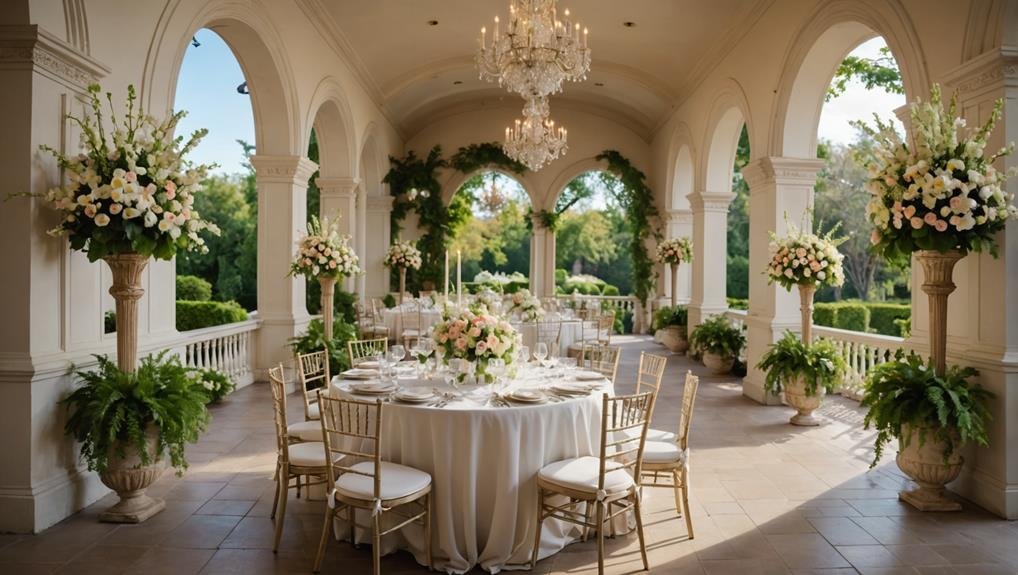
Incorporating primroses into wedding decor adds a touch of delicate beauty and romantic symbolism, making them a popular choice for various floral arrangements. These charming flowers are celebrated for their pastel hues and sweet fragrance, which can enhance the ambiance of a wedding ceremony or reception.
Primroses are versatile and can be seamlessly integrated into multiple elements of wedding decor, from bridal bouquets to centerpieces and boutonnieres. Primroses are particularly favored in spring weddings due to their natural blooming season, allowing them to complement other springtime flowers beautifully. Their symbolism of young love and new beginnings makes them an especially meaningful choice for weddings.
Here are some common uses of primroses in wedding flower arrangements:
- Bridal Bouquets: Primroses can be combined with other flowers to create stunning, romantic bouquets.
- Centerpieces: These flowers add a soft, natural look to table arrangements, enhancing the overall decor.
- Boutonnieres: Primroses make elegant additions to groom and groomsmen's boutonnieres.
- Ceremony Arches: Incorporating primroses into arches or altarpieces brings a whimsical touch to the ceremony setting.
- Floral Crowns: Brides and bridesmaids can wear primrose-adorned crowns for a fairytale-like appearance.
Their delicate nature and subtle elegance make primroses an excellent choice for enhancing wedding florals.
Alternative Flower Types
Exploring alternative flower types for wedding arrangements can provide unique and personalized touches that reflect the couple's individual tastes and wedding theme. While primroses are an excellent choice with their delicate, colorful blooms and symbolism of young love, other flowers can equally enhance the aesthetic appeal of a wedding.
For instance, tulips are a fresh option, offering a variety of vibrant colors such as red, yellow, and purple. Their sleek, elegant appearance makes them suitable for both modern and traditional wedding themes.
Another alternative is the ranunculus, known for its lush, layered petals and wide range of hues. These flowers are particularly popular in romantic and whimsical arrangements, adding a fresh touch to bouquets and centerpieces.
Anemones, with their striking dark centers and bright petals, are another versatile choice. They bring a bold statement to any arrangement and are perfect for couples seeking a fresh and contemporary look.
Finally, sweet peas, with their delicate fragrance and soft pastel colors, can infuse a sense of freshness and charm into wedding decor.
Each of these flowers offers distinct characteristics, allowing couples to tailor their floral designs to create a memorable and personal wedding experience.
